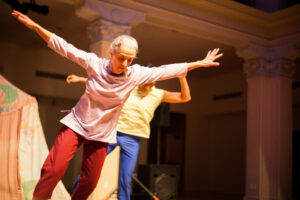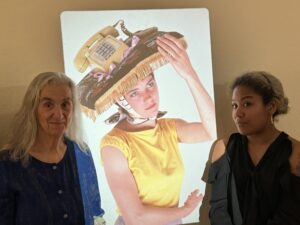Photo by Warren Franklin
[ID: A bright, partly cloudy day on a hillside with trees on the horizon. Four women, with their backs to us, look at and beyond a tall tent made out of pastel colored chenille. They vary in heights, frames, and hairstyles, but are all wearing a white tank top and flowy white pants.]
Wendy Rogers’ backstory: Since 2011, See What Happens (SWH) recovers and explores the material and lived archive of my Body of Work (1968-present). Together with multi-generational collaborators, I repossess moving artifacts, while generating dances arising from the emerging present. We reinterpret, re-mix and repurpose. We engage directly with the temporality of dance and a dancer’s body, raising questions of who dances how over time. I also tap the material Body of Work — video and audio recordings, costumes, sets, photos, etc. — to construct public offerings of live performance, exhibition, digital media and/or talkstory. Every studio and storage foray fills me with gratitude for work made and life lived with extraordinary artists. Names exceed word count.
I am grounded in the radical pedagogy of Ruth Hatfield begun in childhood, Berkeley, 1957. Movement exploration is primary. Years of study and/or performance with modern/postmodern artists (e.g. David Wood, Margaret Jenkins, Merce Cunningham, Sara Rudner) led me to a neo-experimental approach, set and improvised work. I dance in dialogue with the work of others across decades, following composer Lou Harrison’s words: “Cherish, conserve, consider, create.” In multi-year projects, dancing evolves into specific performances allied to occasion and place and persons. I commit to shared authorship with dancers and collaborating artists.
In fall 2019, after two decades as an expat in the Inland Empire, I pulled up stakes, and headed home to the East Bay where I grew up dancing and later established the Wendy Rogers Dance Company (WRDC 1978-1990). The pandemic interrupted my third ten-year project, SWH (2011-2020). The ‘2020 vision’ I had imagined became a blur. Political turmoil, climate disasters, social upheaval imbued with appalling racial injustice, as well as extreme and residual circumstances of pandemic, call everything into question.

[ID: An older woman in an auditorium jumping and looking down with her arms outstretched. She is wearing a pink long sleeved blouse and red trousers. A Brown man is seen behind her and to the right jumping. He is wearing a yellow sleeveless tank top and blue trousers. A pastel chenille tent peeks out.]
Piper here. Hi! We’ll get to why I’m here in a second, but I want to introduce myself. I’m a Black and Japanese, Queer, female storyteller and artist. My mediums are dance and language arts. I love living in the East Bay and am grateful to the Ohlone peoples for their stewardship of this land and acknowledge that we are living on their unceded ancestral home. Dance is the only thing I have always known I have wanted to do forever. Starting at age 3, I have never stopped. It has saved my life in many ways, many times. Studying grant writing became a way to support and secure my space in the arts. My work with Wendy, among the many benefits, validates that I made the right decision in following my passions. Especially in the service of something bigger than myself.
Wendy continues: And then, in the midst of 2020 quarantine, wendyrogersdancing.com, a digital venue for SWH, crashed. Recommendations led me to Piper Thomasson. The archive in its entirety became our project. Piper helps me write proposals. (Also, there was the night she joined me to rescue the archive from a flooding storage space.) We share mutual excitements considering our perspectives on present times: mine as a White, seasoned dance artist with roots in seventies activism; hers as a smart, Black dance artist with stories to tell. We share an agenda to bring more recognition to East Bay dance cultures. Her support and challenges shape SWH in ways that reassure me of its value. We both have a stake in what we want to learn from the past and to achieve going forward. Our collaboration mirrors the project itself.
Hi again. I agree with Wendy; let me name that in no uncertain terms. Even at the beginning, my input in proposal writing about why this project is relevant and worthwhile has influenced SWH. In real time, we are contributing to the archive and everything that the archive will be.
I grew up in Stockton, CA. Plenty can be said about that city. For example: “I love it.” Or, “As far as I’m aware, it was no hub for arts or dance culture when I was growing up in the nineties.” It’s certainly gotten better — Shout out to Elazar Abraham and HATCH Workshop — but I wasn’t patient. I moved to the Bay Area wanting to be amongst artists and art, armed with my passion, curiosity, and work ethic.
Even after a(n unexpectedly) rich experience earning a degree in Dance in the Silicon Valley, it wasn’t until I moved to the East Bay and encountered Wendy and her archive that I learned how radically possible and democratic the process of art making could be. Wendy already had a great prototype with her 10-year project approach. I knew this needed to be shared. The Body of Work is so rich, and what Wendy is doing with it and how she’s sharing it have the potential to set a powerful precedent for collaboration and reflection.
Part of what intrigued me was Wendy’s rejection of the conventional funding schedule. Grant and fellowship cycles became a part of her extended creative process, not the process being beholden to the cycle. AND YES. I recognize the privilege necessary to be able to do that…but I never thought I’d see a White artist choose to reject a system built for them. Not only was Wendy working outside of that system, she did it successfully. For me this shows “it’s possible” instead of “is it even possible?” to change the way art is made, funded, appreciated and recognized.
Wendy closes: Instead of ending, SWH has become an ongoing way to be, whether instigating activities or welcoming opportunities generated by others. I reinvent how to move in studio time with Sara Rudner and Risa Jaroslow, dance mates from NYC circa 1975, together again in the East Bay! I have relished interacting with the mix of dance artists gathered by Margaret Jenkins’ Encounters Over 60. I was her student circa 1971. I continue making work with Jennifer Jerum and John Diaz, dance mates from SoCal since 1997. A recording of one of my stories circulates nationally (and without me) accompanying dancers in The Running Show (2018-present), created by Monica Bill Barnes and Robbie Saenz de Viteri. Monica was my student in San Diego circa 1993. Piper and I research potential homes for set paintings and other collaborations (1976-1988) with NYC artist Robert Kushner. I am remastering groundbreaking, electronic music from the seventies. Bay Area composer Paul DeMarinis recently sent me a tape I had forgotten, 3 Easel Studies for Wendy Rogers, realized in 1975 on the Buchla Music Easel. How inviting for a next SWH venture.

[ID: An older White woman and a young Black woman looking mischievous on either side of a slide projected on a wall. The slide has a White woman looking off to the right, holding a yellow sleeveless blouse. Her left hand is holding her hat, which is made out of a decorative pillow.]
This article appears in the Winter 2024 issue of In Dance.
Wendy Rogers has choreographed and performed contemporary dances for 55 years, in the SF Bay Area, NYC and SoCal, where she taught contemporary dance at UC Riverside 1996-2016. Honors include Fellowships from the Foundation for Contemporary Arts, the Guggenheim Foundation, the National Endowment for the Arts, the Irvine Fellowship in Dance and a 2009 Fulbright in Malaysia.
Piper Thomasson has English and Dance BAs from Santa Clara University where she received the Anna Halprin Award for Excellence in Dance and the Gracelyn Rillorta Bateman Award for Inclusive Excellence. More recently, she’s a CCI Cali Catalyst Award winner and dancer with Antoine Hunter’s Urban Jazz Dance Company.


